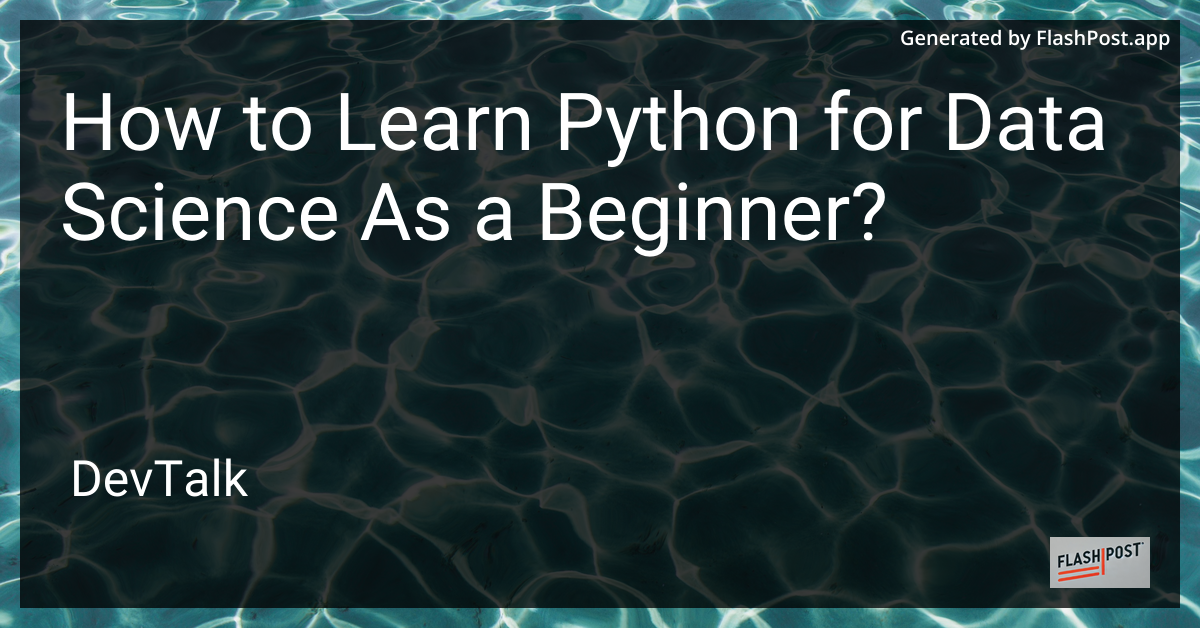How to Learn Python for Data Science As a Beginner?
 # How to Learn Python for Data Science as a Beginner
# How to Learn Python for Data Science as a Beginner
If you are a newcomer to the world of data science, learning Python is an essential step.
Python is the backbone of data science, used for data manipulation, analysis, and visualization. In this article, we will guide you through the process of learning Python for data science as a beginner.
Why Choose Python for Data Science?
Python offers several benefits:
- Simplicity and Readability: Python's syntax is clean and easy to read, making it an excellent choice for beginners.
- Extensive Libraries: Python boasts a rich ecosystem of libraries such as NumPy, pandas, and Matplotlib, which are specifically designed for data science.
- Community Support: Python has a large, active community, offering a wealth of resources and support.
Before delving into data science-specific libraries, it’s crucial to have a solid understanding of Python basics.
Step 1: Master the Basics of Python
Start your journey by getting familiar with the fundamental concepts of Python:
- Variables and Data Types: Understand different data types like strings, integers, and floats.
- Control Structures: Learn about conditionals (
if,else,elif) and loops (for,while). - Functions: Know how to define and call functions, along with understanding return statements.
- Data Structures: Explore lists, tuples, dictionaries, and sets.
You can find numerous free resources and tutorials online, including official Python documentation.
Step 2: Learn Python Libraries for Data Science
Once you are comfortable with the basics, it’s time to delve into libraries specialized for data science:
- NumPy: Essential for numerical computing, NumPy provides support for large, multi-dimensional arrays and matrices.
- pandas: Ideal for data manipulation and analysis, pandas excels in handling and analyzing structured data.
- Matplotlib and Seaborn: Used for data visualization, these libraries help in creating static, interactive, and animated visualizations.
- SciPy: Built on NumPy, SciPy offers additional tools for optimization, integration, and statistics.
- Scikit-learn: A powerful library for machine learning, Scikit-learn is used for classification, regression, clustering, and more.
Step 3: Practical Application and Projects
Solidify your knowledge by applying it to real-world problems:
- Start with Simple Projects: Begin with projects like analyzing a dataset or building a simple data visualization.
- Collaborate and Share: Participate in online communities like Kaggle to engage with other aspiring data scientists.
- Continuous Learning: Data science is an ever-evolving field. Keep learning by following blogs, attending webinars, and taking courses.
Additional Learning Resources
Enhance your Python knowledge with related topics:
- To explore Python web development, consider learning frameworks like Flask or Django.
- Delve into GUI applications by learning about wxPython menu item functionality and wxPython dynamic positioning.
Conclusion
Learning Python for data science as a beginner can be a rewarding experience. By mastering the basics, understanding key libraries, and applying your skills through projects, you’ll be well on your way to becoming proficient in data science. Always stay curious and keep exploring the vast world of Python and data science.
Happy coding!